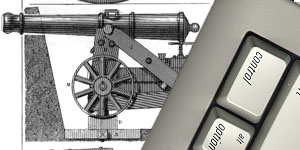


Cold Warriors
During the Gulf War, the United States Navy lost two major ships---a large helicopter carrier and a cruiser---because it wasn't prepared for new-technology mines. In the past, mines were simply bombs studded with contact switches and they floated just below the surface. Any ship or submarine hitting one of the switches activated the mine. The Navy had prepared for that century-old mine technology with a new helicopter-based minesweeper that dragged a sled just below the surface to detect and catch all such mines. The problem was that, besides the old style dumb mines, Iraq used much cleverer Russian and Italian ones.Instead of floating near the surface, these mines often live on the sea bottom; and instead of simple contact switches, they have sophisticated sensors, a computer, and memory. Some of them detect passing ships through changes in sound, heat, light, magnetic fields, or water pressure and then blow up under them.
Such smart mines can play endless tricks. For example, they can be programmed to be active only at certain times (thereby often eluding minesweepers). Or they can lull suspicion by letting a certain number of ships go by before blowing up under the next one. Some blow up only when a specified number of ships are passing over them or only when a particular kind of ship goes by. Some can even move about on the seafloor, while others wait for a ship or submarine to loiter past before firing a smart torpedo at it.
To combat the new technology, advanced minesweepers take successive sound-wave pictures of the seafloor, comparing the maps produced and looking for differences. They also use tiny remote control submarines to get a close-up look and leave an explosive near anything suspicious.
But technology never stands still---particularly in warfare. If current antimine technology gets good enough, the next generation of mines will simply get smarter. Rather than blowing up any and all ships and submarines, they may recognize friendly ones and let them pass. Rather than metallic (and easy to detect) skins, they may have plastic skins, as some land mines already do. And rather than just hanging around waiting to be found, they may, one day in the far future, hide inside moving schools of fish.
The conclusion is plain. Putting a computer in a weapon makes it much more formidable. Navies may eventually have to resort to more and more mobile and independent antimines until every important ship moves around within a protective cloud of antimines. Such a school of independent attack weapons might also be very useful against a ship's most deadly foe---the submarine. The sea will then be as alive with mobile smart machines as the air is now becoming.